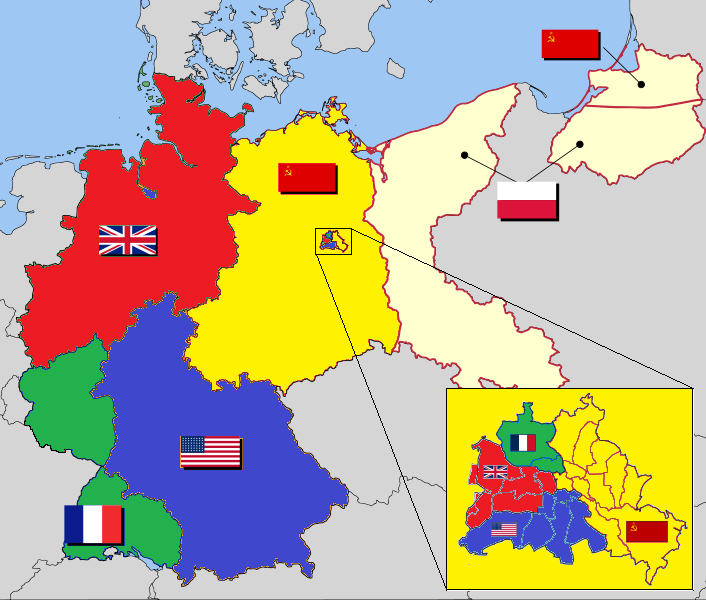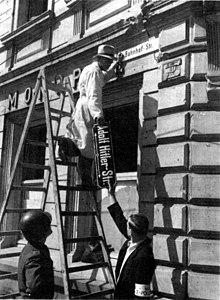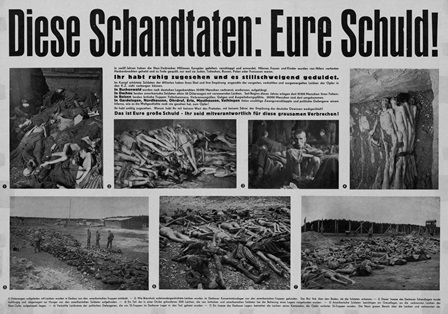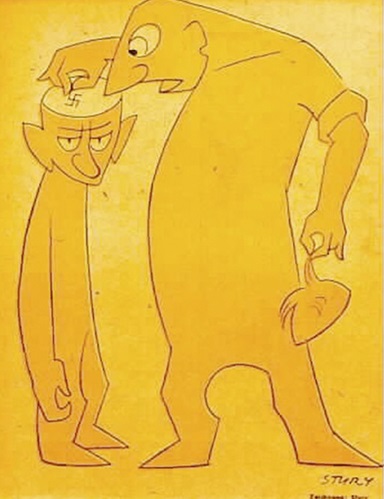|
|
NOTE: this topic is a stated topic only on the OCR specification. It is NOT a topic on the AQA, Edexcel or iGCSE specifications.
|
DismembermentBy the terms of Germany’s surrender in May 1945 – the ‘Berlin Declaration’ – German land was given to Poland, and the rest of the country was divided into four ‘zones’, occupied and initially administered by the USSR, the USA, Britain and France. Berlin was similarly divided into four ‘sectors’. In August 1948, the USA, Britain and France combined their zones into ‘Trizonia’, which became in May 1949 the Federal Republic of Germany (‘West Germany’). As this was the start of the Cold War, however, the Soviet Zone remained separate, becoming the German Democratic Republic (‘East Germany’) in October 1949.
Germany in 1947
|
Going DeeperThe following links will help you widen your knowledge: Basic account from BBC Bitesize US propaganda newsreel - 1947
YouTube Why Denazification failed - Imperial War Museum Nuremburg Trials - Imperial War Museum
|
Denazification: West GermanyDenazification in the Soviet sector had two principles – first to destroy Nazism but, second, to establish Communism as the ruling political force. 1. The Public Space• All trace of Nazism was removed – the swastika was banned/ advocating National Socialist ideas made punishable by death/ signs and posters removed. 2. War Crimes Trials• Nineteen high-ranking Nazis, including, eg, Göring, Hess and Speer, were publicly tried for war crimes at the Nuremberg Trials, which began November 1945 (-Oct 1946); 12 were sentenced to death, three imprisoned for life. 3. Purge of Nazi Party Members• US Zone: the US military was at first zealous – 50,000 public officials were dismissed, and all Germans 18+ were given a questionnaire (German: Fragebogen) to establish if they had been a member of the Nazi Party. By ‘Law 104’ Germans were categorized as: ‘Major offender’/ ‘Offender’/ ‘Lesser offender’/ ‘Follower’/ ‘Exonerated’. There were 5,000 trials and 500 executions. But the process was too huge – by Dec 1945, ½ million forms processed, 4 million waiting, 7 million to come -- for the IBM data machine in Paris to handle. • British Zone: the British, too, started zealously – in June 1945 the interrogation centre at Bad Nenndorf was opened (where detainees were allegedly tortured). Very quickly, however, the British realised that they needed experienced civilians to run the country, so they allowed ‘nominal’ Nazis to become officials and businessmen, and Germans had to complete the Fragebogen only if applying for an position of responsibility. • French Zone: for the French, membership of the Nazi Party was not an issue. They sacked ¾ of the teachers … and then rehired them because there was a shortage of teachers. In the French Zone, only 13 Germans were categorized as “major offenders”. • In 1945-46, Germany was in chaos and needed civilian government, PLUS the Fragebogen was hated, PLUS the Cold War had taken over from Germany as the main international problem … so in 1946 the western Allies handed over denazification to 545 civilian spruchkammer (tribunals). These were much less zealous than the Allies. The Fragebogen was replaced by less-intrusive Meldebogen, action was restricted only to Major Offenders and Offenders, and Germans who could get somebody else to testify for them could get a Persilscheine (‘Persil ticket’ – a certificate of innocence). Meanwhile, a black market flourished in fake certificates. The whole process was abandoned in 1951 with an amnesty. • The US recruited 785 scientists and engineers from Germany to the United States, including high-ranking Nazi and SS officers, to help run its space program and intelligence operations (‘Operation Paperclip’). 4. Re-education and Propaganda• At first, the western Allies followed a policy of collective guilt, and 'psychological cleansing' to eradicate Nazism not just from public life but from people's minds. Newspapers showed photos of Nazi atrocities with the headline: ‘Your Fault’. Germans living near concentration camps were forced to visit them. • The US Army took control of German newspapers & magazines, radio, theatres, cinemas, and publishers. 30,000 book titles, from school textbooks to poetry, were banned; the possession of a book on the list was made a punishable offense. • A number of artists – such as the filmmaker Leni Riefenstahl – were investigated, but were denazified as mere ‘fellow travellers’. The Americans supported the anti-Nazi artist Juro Kubicek financially. • It is generally accepted that many Germans continued to hold Nazi beliefs – a survey in 1952 found that a third of Germans still supported Nazi anti-semitism, and that a quarter had a good opinion of Hitler. 5. Government• In 1949, the Federal Republic of Germany was formed, with Konrad Adenauer, leader of the centre-right Christian Democrat Party, as its Chancellor (1949-63). Its constitution – the ‘Basic Law’ – was based on that of the Weimar Republic. • Adenauer’s policy was stability at home and close alliance with the western Allies in foreign affairs. Both the right-wing Socialist Reich Party and the Communist Party were banned. • The official government line re the War was acknowledging the horrors of 1933-45 but blaming them on ‘a glitch in the works’ (Betriebsunfall) committed by a small group of evildoers, while everybody else simply obeyed orders. 6. Failure• Only 1.4 percent of the people undergoing denazification ended up classified as ‘Major Offenders’ or ‘Offenders’. • In 1948 the political scholar John Herz labelled denazification ‘a fiasco’. • In 1965, Albert Norden, a German communist politician, published the names of 1,800 Nazis of high rank in postwar West Germany – including 15 Govt Ministers, 100 generals & admirals, and 200 high-ranking police officers • Nevertheless, by 1947, the Allies held 90,000 Nazis in detention, and nearly 2 million former Nazis could only work as manual labourers. From 1945 to 1950, more than 400,000 Germans were held in internment camps in the name of denazification.
|
Source A
Taking down an 'Adolf Hitler-Strasse' street-sign in Trier 1945
Source B
'These atrocities your fault' – 1945 propaganda leaflet.
Did You KnowThe Soviets were critical of denazification in the western zones, declaring the new West Germany a continuation of the Nazi regime. However, ex-Nazis retained roles in East Germany too, if they were considered useful to the regime.
Source CIt was a dark page in German history that they want to forget if not to deny … the effect of denazification appears to have been to bar certain persons temporarily from positions of influence rather than to provide for their long-term elimination. John Herz, The Fiasco of Denazification in Germany (1948).
Source D
A 1948 cartoon on the difficulties of denazification.
|
Denazification: East GermanyDenazification in the Soviet sector had two principles – first to destroy Nazism but, second, to establish Communism as the ruling political force. 1. The Public Space• All trace of Nazism was removed – flags, posters, insignia etc. – and it was illegal to display them. 2. War Crimes Trials• The Leipzig War Crimes Trials (1945-1946) dealt with industrialists accused of using forced labour. 3. Purge of Nazi Party Members• 122,000 Nazi Party officials were removed from government, administration, and industry, and imprisoned. The process was conducted by the NKVD, and the camps were run as the Soviet GULAG; perhaps as many as 80,000 of prisoners died. • Tribunals were set up, run by trusted Germans, to convict former members of the Nazi Party; those found guilty were imprisoned, or banned from office. The process was wound up in 1948 after screening between ⅓ and ½ million individuals. 4. Re-education and PropagandaThe Soviet Zone implemented a comprehensive program to ‘re-educate’ the population in socialist and anti-fascist values. • Children’s literature was heavily censored. • Schools, universities, and media underwent ideological transformation, emphasizing the idea that socialism was the answer to fascism. • Propaganda portrayed the Soviet Union as a liberator and friend of the East German people, and Soviet methods of persuasion – youth groups, rallies, festivals and the secret police – were used to build support. • Especial care was taken to look after the POWs returning from horrific conditions in Soviet camps, fearing that they might be violently anti-Soviet. 1948 was declared the ‘Year of the Returnee’, and the SED’s: Volkssolidaritat (‘People's Solidarity’) welfare organisation worked with the churches and 6,000 women’s local anti-fascist committees to look after their physical and mental rehabilitation (though the latter seems to have been rough and ready – see Source A). In 1949, hundreds of Heimkehrer (‘homecomer’) conferences were held to assert the GDR's friendship with the USSR. 5. Government• A Communist Party was established – the Sozialistische Einheitspartei Deutschlands (Socialist Unity Party of Germany: SED), led by Walter Ulbricht – and the Soviets, although they kept their promise to hold elections, made sure that it became the governing party. The SED then set about the 'Sovietisation' of East German society.
|
Did You KnowThe western Allies were critical of denazification in the Soviet zones, with John Herz writing: “In the Soviet sphere, purge of Nazis and Fascists soon became the tool for indicting any opponent of Communist-totalitarian rule and for eliminating him as a ‘fascist collaborator’, whether or not he had been one”. However, the Americans intentionally reconstructed West Germany as a capitalist bulwark against the USSR, and used Nazis in their intelligence and space programs.
Source E“We women in Berlin went through a lot as well … we expect [the Heimkehrer] to be good comrades who will diligently help us with the reconstruction of the country.” Edith Honig, Mood picture of the returning prisoners from the Russian captivity (August 1945).
|
7. FailureTwo facts, however, suggest that all was not well in the GDR: • Migration: Between 1945 and 1952, at least 3 million people fled the Soviet Zone to West Germany, seeking better living conditions and freedom. • The 1953 Uprising: In 1953, Stalin’s death coincided with shortages of food and the introduction of compulsory military service in the GDR. The result was a violent uprising which involved about 1 million people in towns across East Germany. It was brutally suppressed with the help of six divisions (20,000 troops) of the Soviet Army: 10,000 people were arrested, mre than 1,000 served long prison sentences and at least 32 people were executed. The historian Gary Bruce (2003) argued that this near-collapse of the Communist regime in East Germany ensured that the country in the future would be "heavily dependent on Stasi oppression for social control".
|
|
|
|
|
|
Spotted an error on this page? Broken link? Anything missing? Let me know. |
|



